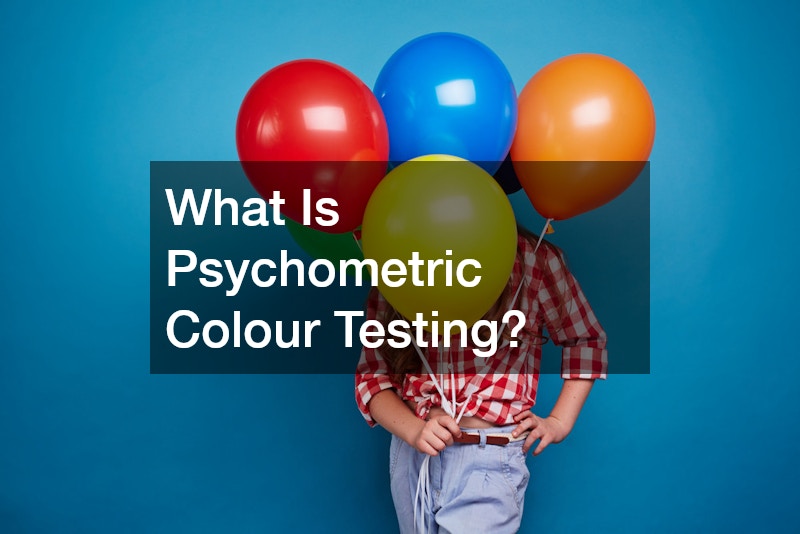
What Is Psychometric Colour Testing?

Psychometric colour testing is a method used to assess an individual’s personality traits, emotions, and psychological state through their responses to colours. This type of testing operates on the principle that colours have a deep psychological impact and evoke specific emotions and associations. By examining a person’s preferences for certain colours or how they respond to different hues, psychometric colour testing provides insight into their mental and emotional wellbeing. The test is used in various fields, including psychology, career counseling, and personal development, to better understand how individuals think, feel, and behave.
The Concept of Colour Psychology
The foundation of psychometric colour testing lies in colour psychology, the study of how colours influence human perception and behavior. Colours can have a profound effect on mood, emotions, and even physiological responses. For example, the colour red is often associated with passion, excitement, or anger, while blue evokes calmness, trust, and stability. These associations are deeply rooted in both biology and cultural influences, making them powerful tools for understanding the human psyche.
Colour psychology has been researched extensively, and many studies have shown that different hues can evoke specific emotions. For instance, warm colours like red, orange, and yellow tend to stimulate and energize, while cool colours like blue, green, and purple are generally associated with relaxation and tranquility. These emotional responses to colours form the basis for psychometric colour testing, which aims to analyze how these colour preferences reflect deeper aspects of an individual’s personality and mental state.
How Psychometric Colour Testing Works
Psychometric colour testing typically involves presenting individuals with a range of colours and asking them to select their preferences or make judgments about the colours. These choices are then analyzed to reveal insights about their personality, emotions, and behavioral tendencies. The test can take different forms, including selecting preferred colours from a set, ranking colours in a specific order, or choosing colours that correspond to certain emotions or personality traits.
One of the most well-known examples of psychometric colour testing is the Lüscher Colour Test, developed by Swiss psychologist Dr. Max Lüscher in the 1940s. The Lüscher Colour Test presents individuals with eight colour cards and asks them to select their preferences. Each colour is thought to represent different psychological states or personality traits. Based on the order in which individuals choose the colours, the test can supposedly reveal aspects of their emotional condition and personality.
Another approach is the Colour Code Personality Test, which divides personalities into four primary colour categories: Red, Blue, White, and Yellow. Each colour represents a dominant personality type, such as Red for power, Blue for intimacy, White for peace, and Yellow for fun. Participants are asked to select the colours they feel best represent their personality or behavior, and the test analyzes their responses to determine their core motivations and behavioral patterns.
The Interpretation of Colour Choices
In psychometric colour testing, the colours people prefer or avoid are believed to reflect their emotional states and personality traits. Different colours are associated with specific psychological characteristics, and interpreting these preferences provides a window into a person’s mind. Below are some common interpretations of colours used in psychometric colour tests:
Red: Red is often associated with energy, passion, and excitement. Individuals who prefer red are typically seen as bold, assertive, and confident. However, red can also signify tension or aggression, depending on the context.
Blue: Blue is linked to calmness, trust, and reliability. People who are drawn to blue may be more introspective, thoughtful, and emotionally stable. They are often perceived as loyal and dependable but may also seek peace and avoid conflict.
Yellow: Yellow represents optimism, creativity, and enthusiasm. Those who favor yellow are often viewed as open-minded, innovative, and energetic. However, in some cases, an overwhelming preference for yellow can indicate anxiety or restlessness.
Green: Green is associated with balance, growth, and harmony. Individuals who prefer green may value security, stability, and personal development. Green is also linked to health and nature, and those who favor it may have a strong connection to their environment.
Black: Black is often seen as a colour of mystery, control, or sophistication. People who prefer black may be more private, reserved, or introspective. Black can also signify a desire for independence or control over one’s surroundings.
White: White represents purity, simplicity, and clarity. A preference for white often indicates a desire for order, openness, and new beginnings. People who choose white may value honesty and seek a clean slate in their lives.
Gray: Gray is associated with neutrality, detachment, and balance. Those who choose gray may prefer to avoid strong emotional responses and stay neutral in conflict situations. Gray can also suggest a need for space and emotional distance.
Purple: Purple is linked to creativity, spirituality, and individuality. Individuals who prefer purple are often seen as imaginative, introspective, and sensitive. They may have a strong connection to art or spirituality.
Watch the video above to learn more about psychometric colour testing!
.





